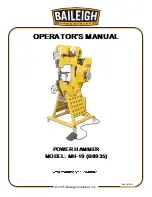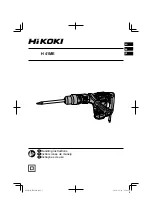
13
GDE 10
Do not run the power tool while carrying it at your side.
Accidental contact with the spinning accessory could snag
your clothing, pulling the accessory into your body.
Regularly clean the power tool's air vents.
The motor's
fan will draw the dust inside the housing and excessive ac-
cumulation of powdered metal may cause electrical ha-
zards.
Do not operate the power tool near flammable materi-
als.
Sparks could ignite these materials.
Do not use accessories that require liquid coolants.
Using water or other liquid coolants may result in electrocu-
tion or shock.
Kickback and Related Warnings
Kickback is a sudden reaction to a pinched or snagged rotating
wheel, backing pad, brush or any other accessory. Pinching or
snagging causes rapid stalling of the rotating accessory which
in turn causes the uncontrolled power tool to be forced in the
direction opposite of the accessory’s rotation at the point of the
binding.
For example, if an abrasive wheel is snagged or pinched by the
workpiece, the edge of the wheel that is entering into the pinch
point can dig into the surface of the material causing the wheel
to climb out or kick out. The wheel may either jump toward or
away from the operator, depending on direction of the wheel’s
movement at the point of pinching. Abrasive wheels may also
break under these conditions.
Kickback is the result of power tool misuse and/or incorrect
operating procedures or conditions and can be avoided by ta-
king proper precautions as given below.
Maintain a firm grip on the power tool and position
your body and arm to allow you to resist kickback
forces. Always use auxiliary handle, if provided, for
maximum control over kickback or torque reaction du-
ring start-up.
The operator can control torque reactions or
kickback forces, if proper precautions are taken.
Never place your hand near the rotating accessory.
Ac-
cessory may kickback over your hand.
Do not position your body in the area where power tool
will move if kickback occurs.
Kickback will propel the tool
in direction opposite to the wheel‘s movement at the point
of snagging.
Use special care when working corners, sharp edges
etc. Avoid bouncing and snagging the accessory.
Corners, sharp edges or bouncing have a tendency to snag
the rotating accessory and cause loss of control or kick-
back.
Do not attach a saw chain woodcarving blade or too-
thed saw blade.
Such blades create frequent kickback
and loss of control.
Special safety instructions for grinding
Use only wheel types that are recommended for your
power tool and the specific guard designed for the
selected wheel.
Wheels for which the power tool was not
designed cannot be adequately guarded and are unsafe.
The grinding surface of centre depressed wheels must
be mounted below the plane of the guard lip.
An impro-
perly mounted wheel that projects through the plane of the
guard lip cannot be adequately protected.
The guard must be attached securely to the electric po-
wer tool and adjusted to ensure maximum safety, i.e.
the smallest possible part of the sanding tool is expo-
sed to the operator.
The guard should protect the opera-
tor from fragments and accidental contact with the sanding
tool.
Wheels must be used only for recommended applicati-
ons. For example: do not grind with the side of cut-off
wheel.
Abrasive cut-off wheels are intended for peripheral
grinding; side forces applied to these wheels may cause
them to shatter.
Always use undamaged wheel flanges that are of cor-
rect size and shape for your selected wheel.
Proper
wheel flanges support the wheel thus reducing the possibi-
lity of wheel breakage. Flanges for cut-off wheels may be
different from grinding wheel flanges.
Do not use worn down wheels from larger power tools.
Wheel intended for larger power tool is not suitable for the
higher speed of a smaller tool and may burst.
Special safety instructions for sanding
Do not use excessively oversized sanding disc paper.
Follow manufacturers recommendations, when selec-
ting sanding paper.
Larger sanding paper extending
beyond the sanding pad presents a laceration hazard and
may cause snagging, tearing of the disc or kickback.
Additional safety instructions
Use only extension cables permitted for outdoor use.
It is not recommended to sand lead paint. Lead paint
should be removed by a specialist only.
Do not work on materials which release hazardous sub-
stances (e.g. asbestos). Take precautions if hazardous,
combustible or explosive dust is likely to occur. Wear pro-
tective dust mask.
Use dust extraction system.
Noise and vibration
Damage to property!
The mains voltage and the voltage specifications on the rating plate
must correspond.
NOTE
Values for the A-weighted sound pressure level and for the
total vibration values can be found in the table on page 6.
The noise and vibration values have been determined in accor-
dance with EN 60745.
CAUTION!
The indicated measurements refer to new power tools.
Daily use causes the noise and vibration values to change.
NOTE
The vibration emission level given in this information sheet has
been measured in accordance with a standardised test given in
EN 60745 and may be used to compare one tool with another.
It may be used for a preliminary assessment of exposure. The de-
clared vibration emission level represents the main applications of
the tool. However if the tool is used for different applications, with
different accessories or poorly maintained, the vibration emission
may differ. This may significantly increase the exposure level over
the total working period.
However if the tool is used for different applications, with different
accessories or poorly maintained, the vibration emission may dif-
fer. This may significantly decrease the exposure level over the to-
tal working period.
Identify additional safety measures to protect the operator from the
effects of vibration such as: maintain the tool and the accessories,
keep the hands warm, organisation of work patterns.
CAUTION!
Wear ear protection at a sound pressure above 85 dB(A).
Summary of Contents for GDE 10
Page 1: ...GDE 10 ...
Page 3: ...3 GDE 10 ...
Page 4: ...4 GDE 10 ...
Page 5: ...5 GDE 10 ...
Page 140: ...140 6 GDE 10 DSH RD150 FLEX P ...
Page 141: ...141 GDE 10 5 FLEX E F G H 1 2 I J L K GDE 10 2 1 1 2 M 1 2 3 4 5 6 7 8 9 ...
Page 143: ...143 GDE 10 3 EN60745 ...
Page 144: ...144 2 GDE 10 ...
Page 145: ...145 GDE 10 1 7 GDE 10 1000 FLEX GDE 10 M ...
Page 146: ...504 424 07 2021 Für Druckfehler keine Gewähr Technische Änderungen vorbehalten ...














































